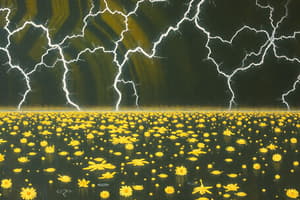Podcast
Questions and Answers
What is the direction of electric field lines around a positive charge?
What is the direction of electric field lines around a positive charge?
- From negative to positive
- Away from the charge
- From positive to negative (correct)
- Around the charge in a circular path
What is the unit of electric charge?
What is the unit of electric charge?
- Joule
- Volt
- Coulomb (correct)
- Ampere
What is the mathematical representation of Coulomb's Law?
What is the mathematical representation of Coulomb's Law?
- F = k * (q1 + q2) / r
- F = k * (q1 - q2) / r
- F = k * (q1 / q2) / r
- F = k * (q1 * q2) / r^2 (correct)
What is the unit of electric field?
What is the unit of electric field?
What is electric potential difference?
What is electric potential difference?
What is Gauss's Law related to?
What is Gauss's Law related to?
What is the electric dipole moment?
What is the electric dipole moment?
What is the nature of the electric dipole moment?
What is the nature of the electric dipole moment?
How does the electric field due to an electric dipole change with distance?
How does the electric field due to an electric dipole change with distance?
What is the constant in Coulomb's Law?
What is the constant in Coulomb's Law?
Flashcards are hidden until you start studying
Study Notes
Electrostatics
Electric Charges
- Electric charges are of two types: positive and negative
- Like charges repel each other, while opposite charges attract each other
- The unit of electric charge is the coulomb (C)
Coulomb's Law
- Describes the electrostatic force between two point charges
- Force is proportional to the product of the charges and inversely proportional to the square of the distance between them
- Mathematically represented as: F = k * (q1 * q2) / r^2
- k is Coulomb's constant, approximately 8.99 x 10^9 N m^2 C^-2
Electric Field
- A vector field that surrounds charged particles
- Electric field lines emerge from positive charges and enter negative charges
- The unit of electric field is newtons per coulomb (N/C)
- Electric field can be calculated using Coulomb's Law
Electric Potential
- Also known as voltage, it's the potential energy per unit charge
- Measured in joules per coulomb (J/C) or volts (V)
- Electric potential difference is the voltage between two points
- Electric potential is a scalar quantity
Gauss's Law
- Relates the distribution of electric charge to the resulting electric field
- States that the total electric flux through a closed surface is proportional to the charge enclosed within the surface
- Mathematically represented as: ∫E · dA = Q / ε₀
- ε₀ is the electric constant (permittivity of free space)
Electric Dipole
- A system of two equal and opposite charges separated by a small distance
- Electric dipole moment is a measure of the strength of the dipole
- Electric dipole moment is a vector quantity
- Electric field due to an electric dipole decreases with distance
Electric Charges
- Electric charges come in two types: positive and negative
- Like charges repel each other, while opposite charges attract each other
- The unit of electric charge is the coulomb (C)
Coulomb's Law
- Describes the electrostatic force between two point charges
- Force is proportional to the product of the charges and inversely proportional to the square of the distance between them
- Mathematical representation: F = k * (q1 * q2) / r^2
- k is Coulomb's constant, approximately 8.99 x 10^9 N m^2 C^-2
Electric Field
- A vector field surrounding charged particles
- Electric field lines emerge from positive charges and enter negative charges
- Unit of electric field is newtons per coulomb (N/C)
- Electric field can be calculated using Coulomb's Law
Electric Potential
- Also known as voltage, it's the potential energy per unit charge
- Measured in joules per coulomb (J/C) or volts (V)
- Electric potential difference is the voltage between two points
- Electric potential is a scalar quantity
Gauss's Law
- Relates the distribution of electric charge to the resulting electric field
- Total electric flux through a closed surface is proportional to the charge enclosed within the surface
- Mathematical representation: ∫E · dA = Q / ε₀
- ε₀ is the electric constant (permittivity of free space)
Electric Dipole
- A system of two equal and opposite charges separated by a small distance
- Electric dipole moment measures the strength of the dipole
- Electric dipole moment is a vector quantity
- Electric field due to an electric dipole decreases with distance
Studying That Suits You
Use AI to generate personalized quizzes and flashcards to suit your learning preferences.




